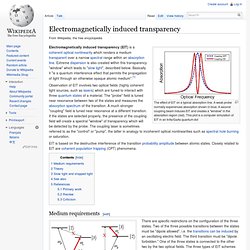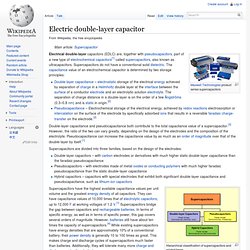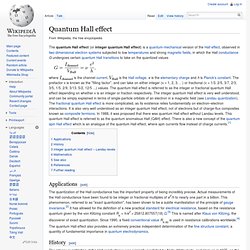

Electromagnetically induced transparency. The effect of EIT on a typical absorption line.

A weak probe normally experiences absorption shown in blue. A second coupling beam induces EIT and creates a "window" in the absorption region (red). This plot is a computer simulation of EIT in an InAs/GaAs quantum dot Observation of EIT involves two optical fields (highly coherent light sources, such as lasers) which are tuned to interact with three quantum states of a material.
The "probe" field is tuned near resonance between two of the states and measures the absorption spectrum of the transition. EIT is based on the destructive interference of the transition probability amplitude between atomic states. Medium requirements[edit] EIT level schemes can be sorted into three categories; vee, ladder, and lambda. There are specific restrictions on the configuration of the three states.
Also important are the dephasing rates of the individual states. Is especially important; ideally should be a robust, metastable state. Theory[edit] to . . Spatial Light Modulator Enables Optical Processor (Photonics Spectra. Hank Hogan Lenslet Ltd. of Herzliyya, Israel, has developed a commercial optical digital signal processor that can perform 8 trillion multiply-and-accumulate operations per second, orders of magnitude faster than current processors.

Applications of the EnLight256 include real-time video compression, which allows higher-quality video to run in narrower bandwidth or noisier channels and which could be important for high-definition television. Other uses lie in military or security, and Lenslet is attracting customers in these areas. "Defense organizations have traditionally been early adopters of breakthrough technologies, and such is the case here," said Avner Halperin, the company's vice president of business development. He noted that security applications might include high-resolution, real-time scanning of baggage and cargo and that military applications might include advanced radar, electronic warfare and video surveillance systems. What is optical computer (photonic computer)? Definition from WhatIs.com - see also: photonic computer.
Is graphene a miracle material? Click's Dan Simmons looks at graphene's chances for 1bn euros of funding The material graphene was touted as "the next big thing" even before its pioneers were handed the Nobel Prize last year.

Many believe it could spell the end for silicon and change the future of computers and other devices forever. Graphene has been touted as the "miracle material" of the 21st Century. Said to be the strongest material ever measured, an improvement upon and a replacement for silicon and the most conductive material known to man, its properties have sent the science world - and subsequently the media - into a spin. "Our research establishes graphene as the strongest material ever measured, some 200 times stronger than structural steel," mechanical engineering professor James Hone, of Columbia University, said in a statement. "It would take an elephant, balanced on a pencil, to break through a sheet of graphene the thickness of Saran Wrap [cling film]. " "It is not even one material. Could Graphene Replace Semiconductors? (PhysOrg.com) -- “People want a faster computer chip,” Philip Kim tells PhysOrg.com.
“And it needs to be smaller. But in order to increase the speed of the chip, or to get it smaller, we are approaching a point where you need materials other than silicon.” Kim, professor at Columbia University, believes that graphene may be just that material. Along with his colleagues, Bolotin, Sikes, Hone and Stormer, Kim thinks that suspended graphene may provide the transport capability needed to reach greater speeds in computer ships. How ultracapacitors work (and why they fall short) — Cleantech News and Analysis. Electric double-layer capacitor. Electrical double-layer capacitors (EDLC) are, together with pseudocapacitors, part of a new type of electrochemical capacitors[1] called supercapacitors, also known as ultracapacitors.

Supercapacitors do not have a conventional solid dielectric. The capacitance value of an electrochemical capacitor is determined by two storage principles: Graphene and it's Applications. Quantum Hall effect. The quantum Hall effect (or integer quantum Hall effect) is a quantum-mechanical version of the Hall effect, observed in two-dimensional electron systems subjected to low temperatures and strong magnetic fields, in which the Hall conductance G undergoes certain quantum Hall transitions to take on the quantized values where is the channel current, is the Hall voltage, e is the elementary charge and h is Planck's constant.

The prefactor ν is known as the "filling factor", and can take on either integer (ν = 1, 2, 3, .. ) or fractional (ν = 1/3, 2/5, 3/7, 2/3, 3/5, 1/5, 2/9, 3/13, 5/2, 12/5 ...) values. The quantum Hall effect is referred to as the integer or fractional quantum Hall effect depending on whether ν is an integer or fraction respectively. Applications[edit] History[edit] The integer quantization of the Hall conductance was originally predicted by Ando, Matsumoto, and Uemura in 1975, on the basis of an approximate calculation which they themselves did not believe to be true.